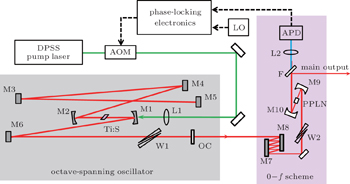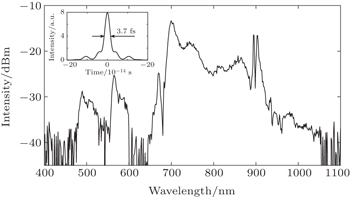† Corresponding author. E-mail:
‡ Corresponding author. E-mail:
Project supported by the National Basic Research Program of China (Grant No. 2012CB821304) and the National Natural Science Foundation of China (Grant Nos. 11078022 and 61378040).
We demonstrate a carrier-envelope phase-stabilized octave-spanning oscillator based on the monolithic scheme. A wide output spectrum extending from 480 nm to 1050 nm was generated directly from an all-chirped mirror Ti:sapphire laser. After several improvements, the carrier-envelope offset (CEO) beat frequency accessed nearly 60 dB under a resolution of 100 kHz. Using a feedback system with 50-kHz bandwidth, we compressed the residual phase noise to 55 mrad (integrated from 1 Hz to 1 MHz) for the stabilized CEO, corresponding to 23-as timing jitter at the central wavelength of 790 nm. This is, to the best of our knowledge, the smallest timing jitter achieved among the existing octave-spanning laser based frequency combs.
Octave-spanning laser based frequency combs have increasing applications in many fields like frequency metrology[1] and optical spectroscopy,[2,3] benefiting from the direct output broad spectra from the oscillators.[4,5] Currently, the most widely used technique to measure and control the CEO frequency (fceo) of an octave-spanning oscillator is the so-called self-referenced scheme,[6–11] in which the supercontinuum generation and f–2 f interferometer are essential for the fceo detection. However, the apparatus employed in these two procedures are relatively complex and bulky in size, and the stability of the fceo signal is sensitive to the fiber coupling and the double-optical-path alignment of the f–2 f systems. Moreover, a considerable portion of the laser beam should be split off the main output to the interferometer to generate the fceo beat note, which inevitably decreases the output power available for the subsequent experiments.
In 2005, a novel CEO measurement technique based on the difference frequency generation (DFG) was proposed by Fuji et al.[12,13] This scheme, which is termed the monolithic scheme or 0–f scheme, has a simple coaxial light configuration and has been demonstrated to possess relatively lower phase noise in comparison with the traditional self-reference method.[13,14] Besides, beam splitting is not necessary here and there is almost no power loss in the process of fceo measurement. Nevertheless, the utilization of the monolithic CEO stabilization scheme is still limited to the oscillators with quasi-octave-spanning spectra[15–18] so far, because both the high single-pulse energy and broad output spectrum of an oscillator are essential conditions to cause strong nonlinear processes for the fceo signal generation.[19,20] This, on the other hand, indicates that the octave-spanning lasers, which have broader output spectra and thus potentially shorter pulse durations compared with quasi-octave-spanning lasers, would be more suitable to adopt the monolithic method for the CEO control.
Up to now, there is no report about the CEO stabilized octave-spanning laser by use of the monolithic scheme. In this paper, we first experimentally demonstrate the octave-spanning laser based frequency comb by use of the monolithic CEO stabilization scheme. A wide spectrum ranging from 480 nm to 1050 nm was directly generated from an all-chirped mirror Ti:sapphire laser. With this monolithic method, the signal-to-noise ratio (SNR) of fceo of the octave-spanning laser was measured to be as high as 58 dB under a resolution of 100 kHz. This is, to the best of our knowledge, the highest fceo SNR among the existing octave-spanning laser based frequency combs. Using a phase-locking loop with a feedback bandwidth of 50 kHz, we realized an IPN (integrated from 1 Hz to 1 MHz) of 55 mrad for the locked CEO beat signal, equivalent to a timing jitter of 23 as at the central wavelength of 790 nm. The Allan deviation (1-s gate time) of the fceo is 2×10−17 to the optical carrier frequency. These good performances in phase noise and long-term stability derive from the high stability of our oscillator and the monolithic CEO detection method.
The octave-spanning frequency comb, as revealed in Fig.
After carefully adjusting the alignment of the oscillator, more than 310-mW stable Kerr-lens mode-locked (KLM) pulses could be obtained under 4.5-W pump power from the diode-pumped solid-state laser. Figure
After dispersion pre-compensation by a DCM pair (M7, M8) and wedges (W2) outside the cavity, the output pulses were tightly focused into a 3-mm periodically poled lithium niobate (PPLN) crystal. The poling period of this crystal (17.84 μm) is specifically designed in terms of the oscillator’s spectrum distribution. New spectral components around 1.6 μm were generated by both the self-phase modulation (SPM) and DFG inside the PPLN crystal at the same time. It is worth noting that the frequency difference between the produced components from the SPM and the ones from the DFG is exactly the fceo value of the octave-spanning laser.[12] In the experiment, we employed a long-pass filter lens (L2) to filter out the components around 1.6 μm to realize this collinear frequency-beat process. Ultimately, the free running fceo beat signal was directly detected by an infrared InGaAs avalanche photodiode (APD, New Focus 1181-FS).
We experimentally found the fceo signal in the monolithic theme was sensitive to the output power of the oscillator and the dispersion compensation outside the laser cavity. In order to obtain a strong beat note, we explored the SNR of the fceo as functions of average power incident on the PPLN crystal (under −270-fs2 net GDD provided outside the cavity) and the net GDD provided outside the cavity (under 313-mW power incident on the PPLN crystal), as shown in Fig.
Figure
The phase error signal detected by the APD was then feedback to change the power of the pump light via an acoustic optical modulator (AOM). A local quartz crystal oscillator was employed as an external crystal oscillator. The in-loop noise performance of the stabilized fceo beat signal is directly measured and revealed in Fig.
For a quantitative analysis of the noise property, the power spectral density (PSD) was measured and displayed in Fig.
Long-term locking of the fceo signal could be achieved due to the high stability of the monolithic CEO stabilization scheme. The locking result around 90 minutes is shown in Fig.
We first utilized the monolithic CEO stabilization scheme to measure and control the fceo beat note of an octave-spanning oscillator. After a series of improvements, the CEO beat note with a 58-dB SNR (RBW = 100 kHz) was achieved, which is the highest fceo SNR among the octave-spanning laser based frequency combs to date. When locked to an extra crystal oscillator, the phase error signal of fceo was obviously suppressed within the feedback bandwidth of the phase-locking loop. We realized the residual phase noise was only 55 mrad (integrated from 1 Hz to 1 MHz), equivalent to a timing jitter of 23 as at the center wavelength of 790 nm. This little jitter between the carrier and envelope phase will have a directly positive impact on the consequent applications, such as the multispectral coherent synthesis and the intense field control of the attosecond pulse generation.
| 1 | |
| 2 | |
| 3 | |
| 4 | |
| 5 | |
| 6 | |
| 7 | |
| 8 | |
| 9 | |
| 10 | |
| 11 | |
| 12 | |
| 13 | |
| 14 | |
| 15 | |
| 16 | |
| 17 | |
| 18 | |
| 19 | |
| 20 | |
| 21 | |
| 22 | |
| 23 |








